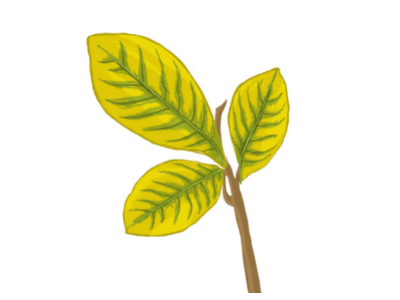This blog is available in the following languages: English, German. Click to translate.
Iron (Fe) is one of the 13 micronutrients all plants need to be healthy and productive. With an iron deficiency, essential functions of plants such as chlorophyll production, energy transfer, enzyme production, receiving oxygen, plant metabolism and development cannot take place, making this nutrient deficiency important to keep under control.
When (and why) is it important to monitor symptoms of an iron deficiency
It is important to monitor the symptoms of your plants earlier rather than later, as prevention methods for iron deficiencies are much easier than treatment.
The absorbency of iron is highly reliant on pH level. For example, if the growing medium is above the measurement of pH 6.5, iron will convert into a form that is no longer accessible to the plant, resulting in an iron deficiency.
It is vital to monitor your plants closely if your growing medium is alkaline or has a sufficient amount of lime added, as this is a common cause for an iron deficiency.
pH levels can be reduced by using fertiliser and water with higher acidity. It can take up to several weeks to see improvements. However, if iron levels are still deficient when pH levels are normal, try lowering the rate of the fertiliser being applied. Adding chelated iron to your fertiliser is a quick alternative solution to boost the green in your plants. Further on this article, we expand further on the sources of iron to use for this particular deficiency.
Iron’s role in plant health
Iron (Fe) in plants acts much like how it does in the human bloodstream – it assists with transporting oxygen through a plant's circulatory system. Iron plays an important role in the formation of chlorophyll, which is key for photosynthesis and gives plants their green colour. Iron is classified as a micronutrient, meaning plants need lesser amounts compared to macronutrients.
Iron however, is not easily absorbed and can only be sufficiently taken up by the roots in specific forms, under specific conditions.
As mentioned above, iron absorbency is highly dependent on the pH range of the plant type.
What are the symptoms of iron deficiency in plants?
Now we understand the importance of iron, how do you identify the symptoms of an iron deficiency? One of the most obvious signs is leaf chlorosis. This is where the leaves of the plant turn yellow and the veins of the leaves remain dark green.
If you don’t treat these symptoms soon enough, the leaf tips will start to burn, which, unfortunately you can't save. (It's best to snip the burned edges away to prevent them from rotting.) Typically, leaf chlorosis begins at the tips of new growth and as the deficiency worsens, it will work its way to the older leaves.

Symptoms to look out for include:
- Leaf chlorosis – yellowing of plant leaves with green veins
- Yellow leaves occasionally turning white if worsened
- Signs of necrosis where flowering and plant growth is inhibited
- Poor growth and leaf loss
- Intense yellowing on the young leaves
- Growth shoots between veins
What causes plant iron deficiency?
Similar to a number of nutrient deficiencies, an iron deficiency in plants can be caused by a nutrient imbalance with the one most common cause being high alkaline soil.
In areas where there is a high rainfall, you will find a lower pH reading, as the soil is more acidic. This is due to the calcium and lime in the soil becoming water-soluble.
Just a note that the nutritional needs required can vary, depending on the species. For example, if we look at the following plant groups, they vary in their nutritional needs and can be separated based on their uptake of iron.
%20(1)-png.png)
Petunias
These plants are known as an iron-inefficient species which are prone to iron deficiency at a high substrate pH. Petunias grow at a lower substrate pH of pH 5.4 - 6.2.
%20(1)-png.png)
Geraniums
Known as iron efficient and are prone to iron and manganese toxicity at a lower pH. They need to be grown at a pH range of pH 6.0 - 6.6 to limit the amount of iron and manganese taken up.
Possible causes of iron deficiency
The most common cause of an iron deficiency is high soil pH (over 6.5 pH.) There may be other factors at play, including:
- Excess of manganese, copper or zinc, which will impact the iron update by your plants
- Over or underwatering your plants in soil causes chlorosis and stress on plants
- The soil has too much clay or is too wet causing oxygen supply in the roots to stagnate
- The substrate contains too much phosphorus
- The root temperature is low
- The root system is not functioning effectively due to dead or damaged roots
- Too much light on the nutrition tank is promoting the growth of algae which uses up the iron
Soil pH and iron deficiency
While it can be tempting to add more fertiliser, the pH of the substrate will affect how much iron can be absorbed by the plant. To fix an iron deficiency, first, test the pH by doing a soil run-off test. Check which ranges your plant should be in. If it's too high (over 6.5), adjust the pH back into a healthy range before you add more fertiliser.
Use a digital pH pen like the Bluelab pH Pen to measure soil run-off.
Once certain it's not a pH issue, there are plenty of good sources of iron available.
Good sources of iron for plants
Once you have identified your crops are lacking in iron, you can boost iron levels with the following:
- Liquid Iron (iron sulfate or chelated iron) is a liquid form that you can spray directly on the plant foliage to treat plants. This is a short-term fix, but it will give your plants a booster and back on track. This is commonly applied to roses, vegetables or citrus plants and other acid loving plants
- Powdered or granulated chelated iron will treat the soil and correct pH imbalances. Apply the iron around the root zone of the plant as directed on the package instructions. If your iron supplement also contains fertiliser, ensure it doesn't contain phosphorus as this can also lead to chlorosis. (Commonly applied magnolias, blueberries or camellias.)
Prevention is always the best course of action, so we recommend reading this article on the four plant health checks you should be doing every day.
Good luck fixing your iron deficiency!
Featured products:
Bluelab pH Pen
Other recommended products:
Bluelab Soil pH Pen
Bluelab Multimedia pH Meter



%20(1).png?height=100&name=Blog%20Author%20Bio%20Image%20500x500%20(2)%20(1).png)


Submit a comment